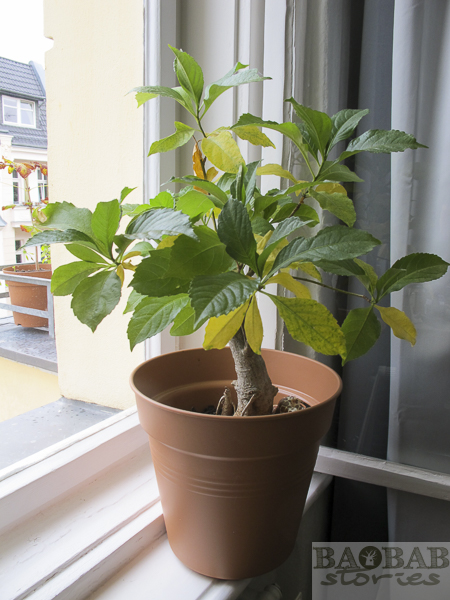The days are getting shorter, it is getting cooler – Autumn is coming. Not only outside, but also for the baobabs on the window sill. The first yellow leaves are clearly visible. Soon the small trees drop all their leaves and are – like most deciduous trees – without leaves in winter.
But wait – the baobab is a tree from Africa! Nevertheless, it lose its leaves like European trees in autumn. This is an amazing fact that Baobabs do so against their natural life cycle. In the
southern hemisphere, and thus also in Africa, spring is currently spreading all over. In a few weeks, the wild cousins of the window sill baobabs will cast their leaves and blossom – just before Christmas.
Secret: Reduced metabolism
Another special feature distinguishes the Baobab compared to deciduous trees outdoors. European trees withdraw their life juices completely from the trunk and branches before winter. This protects them from freezing to death in severe frost. Baobabs in the living room and in the wild, however only slow their metabolism. Therefore, they do not tolerate frost.
The layer of chlorophyll cells under its top layer of bark allows them to continue operating a reduced form of photosynthesis. In this phase, the trees prefer a cooler location and nevertheless bright daylight. Without their leaves they can only absorb little water. If left in a wet pot their roots are susceptible to root rot.
Baobabs sprout their leaves usually just shortly before the onset of the rainy season. The leaves help the trees to absorb as much water as possible with their fibers in their trunks and branches. Therefore the leaves are important to help protect the roots being exposed to standing water which eventually leads to root rot. The stored water helps the baobabs to survive periods of little rainfall or drought conditions.
Turning green in February
When the days are getting longer again in February, the Baobabs on the window sill start sprouting leaves again. The first set of leaves usually do not have the typical digitate form and are rather simple. These are repulsed after a short time and replaced by digitate leaves. They can be up to 9-foliolate although the 5-foliolate is where the Baobab derives its scientific name from. One of the European explorers, Michael Adanson first described Baobabs scientifically. Apparently, he was inspired by the leaf shape, which reminded him of a human hand with five digits. The scientific name reads Adansonia digitata.


I have managed to raise some Baobab Zas from seed.
The leaves are vey yellow, is this normal or am I doing something wrong. They appeared yellow and are still yellow. Temperature here in Spain is not a problema.
cannot someone please advise.
Regards
Gordon
Dear Gordon, thank you for your mail about your adansonia za & congratulations that you managed to grow them from seed! With adansonia digitata which is the species that grows in Madagascar and on the African continent as well: they get yellow leaves before they drop them. usually towards the dry season – baobabs do not have leaves year round – at least not adansonia digitata. I do not know if it is the same with adansonia za. The leaves turning yellow on them could mean that they are ready for their “resting period” which would be African winter (around now). It is very difficult to “diagnose” from far – let me ask you some questions: When did you plant your seeds and when did you repot them last? Have you ever added fertilizer and how often do you water your baobabs? Maybe some of the information here is helpful: https://baobabstories.com/en/grow_baobab_seeds/ or https://baobabstories.com/en/baobabs-watering-soil/
Good luck with your baobabs! Heike
Good day, my baobab seedling’s leaves are also turning yellow. I am a little worried as the seedling has been growing normally until now. see the photo: https://www.dropbox.com/scl/fi/7ix2ksilt5ohmdv98bpof/WhatsApp-Image-2023-12-06-at-15.51.20.jpeg?rlkey=3xugtbajqqciotzahng5n4p0c&dl=0
Nashon Tado
Kenya
Thank you Nashon Tado – it is quite normal that Baobabs drop their leaves. They usually do so after the rainy season. Kind regards, Heike
My baobab, which is in front of a large window & a radiator, keeps its leaves all year round.. Very few of them yellow. I think I’m supposed to stop watering from October to May, but I don’t because I’m afraid it will suffer from the radiator beside it.
Am I doing anything wrong?
PS/ it has two branches of leaves which are unlike the others: less pointed at the tip & less long, & thicker.
Hi Aurea Laranang, thank you for contacting me. Baobabs do keep their leaves as long as they get water regularly. What you describe does not sound like the ideal spot for your baobab in a pot. If you do not have another place where you could keep the tree, I assume it is better to water it. In the wild baobabs drop their leaves because water is scarce after the rainy season. If you keep on watering your plant it has the option to keep the leaves. Kind regards, Heike